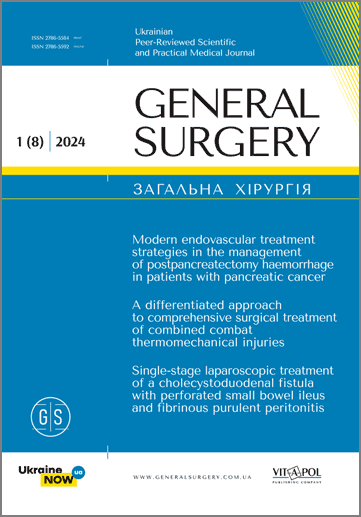Minimally invasive techniques for surgical treatment of sacrococcygeal pilonidal disease
DOI:
https://doi.org/10.30978/GS-2024-1-33Keywords:
pilonidal disease, pilonidal cyst, sacrococcygeal area, minimally invasive techniques, recurrencesAbstract
Sacrococcygeal pilonidal disease (SPD) is a common disease that affects mainly young men and leads to a decrease in their quality of life and a long‑term loss of working capacity. According to the available statistical data, the disease prevalence in Europe and North America ranges from 26 to 40 cases per 100,000 people.
Objective — to determine the effectiveness of minimally invasive techniques for surgical treatment of chronic and recurrent forms of SPD.
Materials and methods. The study included 23 patients with SPD. It was clinical prospective, with a follow‑up period of 18 months. The evaluation criteria were defined as recurrences, the frequency of postoperative complications, the severity of the pain syndrome, the patient’s self‑assessment of the cosmetic effect, the duration of hospitalisation, and the duration of surgery.
The results. The recurrence rate during the 18 months of observation was 39.1%. The overall frequency of postoperative complications was 21.7%. The median duration of surgery was 20 (CI 95% 15—25) minutes, and the median duration of hospitalisation was 2 (CI 95% 1—3) days. The median score of the pain syndrome according to the modified visual analogue scale was 5 (CI 95% 4—5) points on the 0th postoperative day, 3 (CI 95% 3—4) points on the third postoperative day, and 2 (CI 95% 2—2) points on the fifth postoperative day. The cosmetic effect of surgical intervention was rated as rather dissatisfied (17.4%), rather satisfied (52.2%), and completely satisfied (30.4%).
Conclusions. Minimally invasive techniques are effective for the surgical treatment of chronic and recurrent forms of sacrococcygeal pilonidal disease, reducing both the inpatient period and the surgery duration. Minimally invasive surgical treatment for chronic and recurrent forms of sacrococcygeal pilonidal disease has been observed to cause a moderate pain syndrome in the early postoperative period while contributing to satisfactory cosmetic results in the remote period. The surgical treatment of chronic and recurrent forms of sacrococcygeal pilonidal disease with minimally invasive techniques has been found to result in a relatively high recurrence rate (39.1% over 18 months of follow‑up).
References
Abdelatty MA, Elmansy N, Saleh MM, et al. Magnetic resonance imaging of pilonidal sinus disease: interobserver agreement and practical MRI reporting tips. Eur Radiol. 2024 Jan;34(1):115-125. http://doi.org/10.1007/s00330-023-10018-2. Epub 2023 Aug 11. PMID: 37566273; PMCID: PMC10791724.
Chintapatla S, Safarani N, Kumar S, Haboubi N. Sacrococcygeal pilonidal sinus: historical review, pathological insight and surgical options. Tech Coloproctol. 2003 Apr;7(1):3-8. http://doi.org/10.1007/s101510300001. PMID: 12750948.
Di Castro A, Guerra F, Levi Sandri GB, Ettorre GM. Minimally invasive surgery for the treatment of pilonidal disease. The Gips procedure on 2347 patients. Int J Surg. 2016 Dec;36(Pt A):201-205. http://doi.org/10.1016/j.ijsu.2016.10.040. Epub 2016 Oct 29. PMID: 27989917.
Doll D, Petersen S, Andreae OA, et al. Pit picking vs. Limberg flap vs. primary open method to treat pilonidal sinus disease — A cohort of 327 consecutive patients. Innov Surg Sci. 2022 Jun 27;7(1):23-29. http://doi.org/10.1515/iss-2021-0041. PMID: 35974777.
Gips M, Melki Y, Salem L, Weil R, Sulkes J. Minimal surgery for pilonidal disease using trephines: description of a new technique and long-term outcomes in 1,358 patients. Dis Colon Rectum. 2008 Nov;51(11):1656-62; discussion 1662-3. http://doi.org/10.1007/s10350-008-9329-x. Epub 2008 May 31. PMID: 18516645..
Halligan S, Tolan D, Amitai MM, et al. ESGAR consensus statement on the imaging of fistula-in-ano and other causes of anal sepsis. Eur Radiol. 2020 Sep;30(9):4734-4740. http://doi.org/10.1007/s00330-020-06826-5. Epub 2020 Apr 19. PMID: 32307564.
Iesalnieks I, Deimel S, Kienle K, Schlitt HJ, Zülke C. Pit-picking-Operation bei Patienten mit Sinus pilonidalis [Pit-picking surgery for pilonidal disease]. Chirurg. 2011 Oct;82(10):927-31. German. http://doi.org/10.1007/s00104-011-2077-9. PMID: 21424286.
Johnson EK, Vogel JD, Cowan ML, Feingold DL, Steele SR; Clinical Practice Guidelines Committee of the American Society of Colon and Rectal Surgeons. The American Society of Colon and Rectal Surgeons’ Clinical Practice Guidelines for the Management of Pilonidal Disease. Dis Colon Rectum. 2019 Feb;62(2):146-157. http://doi.org/10.1097/DCR.0000000000001237. PMID: 30640830.
Koskinen K, Harju J, Hermunen K. Long-term results for pit-picking and flap procedures in primary pilonidal sinus disease. BMC Surg. 2023 Apr 28;23(1):99. http://doi.org/10.1186/s12893-023-02014-6. PMID: 37118772; PMCID: PMC10142197.
McCallum IJ, King PM, Bruce J. Healing by primary closure versus open healing after surgery for pilonidal sinus: systematic review and meta-analysis. BMJ. 2008 Apr 19;336(7649):868-71. http://doi.org/10.1136/bmj.39517.808160.BE. Epub 2008 Apr 7. PMID: 18390914; PMCID: PMC2323096.
Seow-Choen F, Seow-En I. Pilonidal disease: A new look at an old disease. Seminars in Colon and Rectal Surgery. 2022;33(4):100909. https://doi.org/10.1016/j.scrs.2022.100909.
Søndenaa K, Andersen E, Nesvik I, Søreide JA. Patient characteristics and symptoms in chronic pilonidal sinus disease. Int J Colorectal Dis. 1995;10(1):39-42. http://doi.org/10.1007/BF00337585. PMID: 7745322.
Steele SR, Hull TL, Hyman N, Maykel JA, Read TE, Whitlow CB (Editors) The ASCRS Textbook of Colon and Rectal Surgery: 4th Edition. Springer Nature Switzerland AG. 2022 1-1216. https://www.ascrsu.com/ascrs/view/ASCRS-Textbook-of-Colon-and-Rectal-Surgery/2285000/all/About_ASCRS_Textbook_of_Colon_and_Rectal_Surgery.
Tezel E. A new classification according to navicular area concept for sacrococcygeal pilonidal disease. Colorectal Dis. 2007 Jul;9(6):575-6. http://doi.org/10.1111/j.1463-1318.2007.01236.x. PMID: 17573759.
Downloads
Published
How to Cite
Issue
Section
License
Copyright (c) 2024 Authors

This work is licensed under a Creative Commons Attribution-NoDerivatives 4.0 International License.






